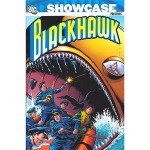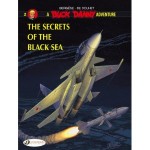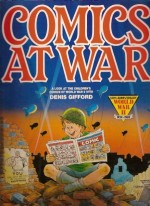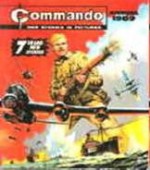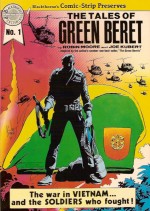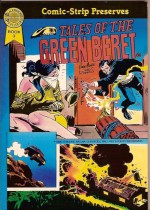
By Joe Kubert, Bob Haney, Archie Goodwin & various (DC Comics)
ISBN: 978-1-4012-1090-2
After the death of EC Comics in the mid-1950’s and prior to the game-changing Blazing Combat, the only certain place to find powerful, controversial, challenging and entertaining American war comics was DC. In fact, even whilst Archie Goodwin’s stunning but tragically mis-marketed quartet of classics were waking up a generation, the home of Superman, Batman and Wonder Woman was a veritable cornucopia of gritty, intriguing and beautifully illustrated battle tales presenting war on a variety of fronts and from many differing points of view .
After the Vietnam War escalated, 1960’s America entered a homefront death-struggle pitting deeply-ingrained establishment social attitudes against a youth-oriented generation with a radical new sensibility. In response DC’s (or rather National Periodical Publishing, as it then was) war books became even more bold and innovative…
This stunning black and white compendium, collecting the lead feature from issues #151-188 (June-July 1970 to June 1975) of the truly venerable Star-Spangled War Stories anthology features one of the very best concepts ever devised for a war comic: a faceless, nameless hero perpetually in the right place at the right time, ready, willing and oh, so able to turn the tide…
The Unknown Soldier was actually a spin-off – having first appeared as a one-off in a Sgt Rock story in Our Army at War #168 (June 1966, by Robert Kanigher & Joe Kubert) – but in 1970 the artist had become editor of the company’s war division and was looking for a new (American) cover/lead character to follow the critically acclaimed “Enemy Ace†(tales of a WWI German fighter pilot) who had been summarily bounced to the back of the book after issue #150).
Written and drawn by Kubert ‘They Came Back From Shangri-La!’ introduced a faceless super-spy and master-of-disguise whose forebears had fought and died in every American conflict since the birth of the nation. Here he took on the identity of B-25 pilot Capt. Shales in 1942 as he participated in vital, morale-building retaliatory bombing raids on Japanese cities. When their plane is shot down over occupied China, “Shales†led his crew through enemy-infested territory to the safety of the Chinese resistance.
From this no-nonsense start the feature grew to be one of DC’s most popular and long-lived: Star-Spangled became The Unknown Soldier in 1977 with #205 and the comic only folded in 1982 with issue #268.
One intriguing factor in the tales is that there is very little internal chronology: the individual adventures take place anytime and anywhere between the bombing of Pearl Harbor and the surrender of Germany and later Japan. This picaresque approach adds a powerful sense of both timelessness and infallible, unflinching continuity.
The Unknown Soldier has always and will always be where he is most needed…
His second adventure ‘Instant Glory!’ found a US patrol captured by the SS as they entered a German city in 1944. An excoriating examination of brutality, heroism and philosophy, the story set the hard-bitten, bitter-edged tone for the rest of the series.
Always economy-conscious and clever with scissors and glue, DC reformatted a number of old stories at this time, particularly old westerns and mystery stories (and even the Phantom Stranger in his first appearances since the 1950s) so it should be no surprise that they would try the same thing with their newest star.
‘Everybody Dies’ was retooled into a new offering by a framing sequence by Kubert, but the body of the tale was originally seen as ‘A GI Passed Here’ (by Irv Novick in Star-Spangled War Stories #36). In its revamped form the saga recounted a grim day in the life of anonymous Eddie Gray as he survived just one more day in the deserts of Nazi-held Africa.
The Unknown Soldier got a full origin in #154’s ‘I’ll Never Die!’ recounting how two inseparable brothers joined up in the days before America was attacked and were posted to the Philippines just as the Japanese began their seemingly unstoppable Pacific Campaign. Overwhelmed by a tidal wave of enemy soldiers the brothers held their jungle posts to the last and when relief came only one had survived, his face a tattered mess of raw flesh and bone…
As the US forces retreated from the islands the indomitable survivor was evacuated to a state-side hospital. Refusing medals, honours and retirement the recuperating warrior dedicated his remaining years to his lost brother Harry and desperately retrained as a one man-army intelligence unit. His unsalvageable face swathed in bandages, the nameless fighter learned the arts of make-up, disguise and mimicry and offered himself to the State Department as an expendable resource that could go anywhere and do anything…
All DC’s titles were actively tackling the issue of race at this time and #155’s ‘Invasion Game!’ (written by Bob Haney) saw the Soldier parachuted into France in Spring 1944 to connect with the Underground’s mysterious leader “Chat Noirâ€. Sent to finalise the plans for D-Day he was horrified to discover the enigmatic commander was a disgraced black US Army sergeant with a grudge against his old country. Chat Noir was too good a character to waste and became a semi-regular cast member…
Haney was on top form for the next epic too. ‘Assassination’ detailed the Immortal G.I.’s boldest mission and greatest failure as he impersonated but could not destroy Hitler himself, after which that aforementioned Sgt Rock classic by Kanigher & Kubert was recycled as an untitled but deeply moving yarn for Star-Spangled War Stories #157.
Haney & Kubert reunited for ‘Totentanz!’ as the faceless warrior broke into a top security concentration camp to rescue a captured resistance leader.
General Patton was the thinly-veiled subject of ‘Man of War’ as the Unknown Soldier was dispatched to investigate a charismatic general who had pushed his own troops to the brink of mutiny, whilst ‘Blood is the Code!’ found him captured and tortured by a Japanese Colonel until he broke to reveal every secret America wanted the enemy to know…
Doug Wildey illustrated Haney’s superb ‘The Long Jump’ as the Soldier infiltrated occupied Holland only to meet more resistance from a stubborn, misguided Dutchman than all the Nazis hunting for the faceless spy, ‘Take My Coward’s Hand’ recycled the 1960 Sgt. Rock story ‘No Answer from Sarge’ (by Kanigher & Kubert from Our Army at War #91) and ‘Kill the General!’ by Haney & Dan Spiegle pitted the Man of a Thousand Faces against Nazi infiltrators determined to assassinate General Eisenhower at the height of the Battle of the Bulge.
‘Remittance Man!’ in #164 saw the anonymous hero replace a legendary spotter on an occupied Pacific island, directing Allied attacks on Japanese strongholds, after which Jack Sparling came aboard as artist in ‘Witness For a Coward’ as a US tank commander sentenced to death for desertion is saved by the testimony of a Nazi Officer – but only after he was abducted from his HQ by the immortal G.I. after which a debt of honour had to be repaid…
Bill Mauldin’s legendary wartime dogfaces “Willie and Joe†(see the superb Up Front for further details) paid an unannounced visit in #166 ‘The True Glory’ as the Unknown Soldier travelled to Italy to find out what was holding up the advance in Haney’s last offering, after which Archie Goodwin steps in to script ‘Three Targets for the Viper!’ wherein the faceless man hunted an assassin set on killing Churchill, Roosevelt and De Gaulle during a conference in 1943 Morocco before jumping to France in 1944 and a close encounter with an American officer determined to make a name for himself at any cost in ‘The Glory Hound!’
Godwin’s tenure saw a stronger concentration on espionage drama, as with issue #169 which found the Immortal G.I. infiltrating the compound where Hitler’s latest secret weapon was being built in ‘Destroy the Devil’s Broomstick!’ after which the Soldier had to stand in for an irreplaceable Marine Major and capture an impregnable island fortress in ‘Legends Don’t Die!’
‘Appointment in Prague!’ offered a rare and tragic glimpse into the Unknown Soldier’s past as he followed the aged actor who taught him the mastery of make-up and impersonation into Nazi-occupied Czechoslovakia to rescue a grandson thought long dead, after which scripter Frank Robbins took over and moved the action to the Eastern Front in ‘A Cocktail For Molotov!’ where the Nazis pulled out all the stops to destroy Russia’s charismatic foreign Minister before he could conclude a treaty with the Allies.
Star-Spangled War Stories #173 saw the G.I. infiltrating a Japanese Submarine base disguised as a Nazi wrestler invited to an exhibition match against a Sumo master. Unfortunately ‘No Holds Barred!’ proved that although allies, Japanese and Germans weren’t exactly friends…
‘Operation Snafu!’ began an extended storyline as it found him impersonating a German tank-commander and forced to sacrifice his own Resistance allies in order to complete a mission vital to the Allied advance, whilst ‘A Slow Burn… From Both Ends!’ gave him the chance to make amends and #176’s ‘Target: the Unknown Soldier!’ ramped up the tension as the Nazis discovered a way to identify the faceless warrior no matter how he was disguised…
With Von Sturm, his deadly Nazi counterpart, on his trail, the Unknown Soldier had stirred up ‘The Hornet’s Nest!’ and was hunted and hounded towards a concentration camp where inmates work as slaves to construct V1 rockets. Trapped, with the net closing around him, he replaced one of the jailers but Von Sturm was determined to deliver ‘The Sting of Death!’ in the spectacular climactic duel to the death…
In Star-Spangled War Stories #179 in the aftermath of his close escape the Immortal G.I. stumbled into ‘A Town Called Hate!’ where racial tensions between white and black American soldiers had devolved into tit-for-tat murders. Unfortunately, whilst disguised as a member of an SS infiltration squad, the Soldier could only exacerbate the situation. With the Germans about to deliver a devastating counter-attack it was a good thing the long-missing Chat Noir was also on hand…
‘The Doomsday Heroes!’ despatched the anonymous agent to the Leyte Gulf where Japanese suicide attacks had stopped the US advance. However before he could begin his mission he was shot down and forced to work with a failed Kamikaze pilot to survive the cruel Pacific seas…
After that tragedy of honour the mission continued with ‘One Guy in the Right Place…’ as the Soldier linked up with natives fighting the Japanese invaders. Disturbingly they are led by an unseen American who sounded like the brother he had lost in the first days of the war. Could Harry have survived all those years…?
Robbins and Sparling bowed out with a classy mini-classic in Star-Spangled War Stories #182, set in Tunisia where ‘A Thirst for Death!’ set the Soldier and a crew of veterans on the sandy trail of Rommel’s hidden petrol reserves, after which new kids David Michelinie & Gerry Talaoc heralded a change of direction with ‘8,000 to One’.
The horror boom in comics was at its peak in 1974 and new editor Joe Orlando capitalised on that fascination with a few startling changes – the most controversial being to regularly reveal the Unknown Soldier’s grotesque, scar-ravaged face – presumably to draw in monster-hungry fear fans…
The story itself went back to the Immortal G.I.’s earliest days as an American agent and saw him sent to Denmark to rescue a ship full of Danish Jews destined for Hitler’s death camps. Disguised as SS Captain Max Shreik, the Soldier was forced to make an unconscionable choice to safeguard his mission. The degree and manner of graphic violence was also exponentially increased to accommodate the more mature readership as the Soldier took a very personal revenge…
‘A Sense of Obligation’ found the now cold, remorseless warrior in France tasked with infiltrating a Special Kommando Training Centre and destroying it from within. However, as with all undercover work, the risk of going too deep and making friends who you might have to kill later inevitably led to another tragic life or death decision for the increasingly grim and soulless Soldier, whilst ‘The Hero’ saw the faceless man invade neutral Switzerland to kidnap a British scientist held by the Nazis. This time his lethal final judgement cost him no sleep at all…
In ‘Man of God… Man of War’ (#186) a Catholic Priest duped into working with the Nazis in Italy became the Soldier’s latest target, but the plan was forestalled and the true situation revealed and rectified after ‘A Death in the Chapel’.
This imposing, impressive and thoroughly entertaining first volume concludes with Star-Spangled War Stories #188 and ‘Encounter’ as the Unknown Soldier strove to prevent the scuttling of a hospital ship by Nazis, unaware that his only ally was in love with the enemy commander…
Dark, powerful, moving and overwhelmingly ingenious, The Unknown Soldier is a magnificent addition to the ranks of extraordinary mortal warriors in an industry far too heavy with implausible and incredible heroes. These tales will appeal to not just comics readers but all fans of action fiction.
© 1970, 1971, 1972, 1973, 1974, 1975, 2006 DC Comics. All rights reserved.

